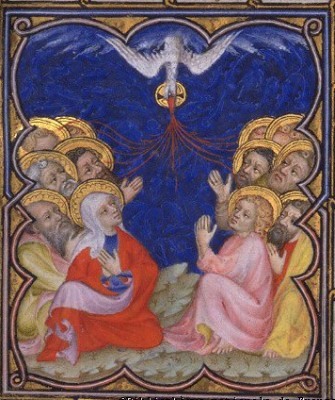 |
| European icon of Pentecost - When the Holy Spirit descended upon the disciples (incl. St. Mary) and the Church was born. |
On the Feast of Pentecost, the 19th of May, 2013, we celebrated four four new births into the Household of God; two adults and two infants. You can see pictures here. The newly Baptized included Yoko Kobori who was introduced to us by a friend and new member at St. Peter's, Tsuneko Nakatani. Greg Musick was introduced to us through Kathy Cox and our annual Multicultural Holiday Craft Fair. And the toddlers (unnamed for child web policy reasons) were introduced to us through their parents, Tony and Stacey (Asato) Edin and Annaka and Fr. James Thibodeaux.
An outdoor Baptism at Pentecost?!
 |
| Baptism at St. Peter's Episcopal, Seattle |
The Church is changing. And here I mean the capital 'C' Church, not just St. Peter's. You may notice that many parishes have become more open and inviting at the Communion Table, having discovered that it is God who invites us to Communion. As this has evolved so have new practices about Baptism.
Baptism has gone from a private event with very little preparation and using very little water to a very public event using LOTS of water and requiring much more formation and learning for the candidates. Baptismal Fonts have taken a prevalent place at the entrances to the worship space, indicating it is through Baptism we enter into God's Household and Covenant of Salvation. And the Book of Common Prayer now indicates that Baptisms should occur on Easter or any of the other 7 Principle Feasts (Can you name them? Hint: Pentecost is one!), emphasizing the importance and meanings of the Sacrament of Baptism. All these changes are a recovery of the Early Church's practice of Baptism.
 |
| Medieval style of Baptism - private and infant focused |
 |
| Ancient Baptismal Font in Rome - public, large, adult and infant focused. The Early Church practice emphasized that Baptism marked public conversion to a Christ-like life. |
For more about Witsunday, Pentecost, traditions, and meanings, see this article from "Full Homely Divinity"
No comments:
Post a Comment